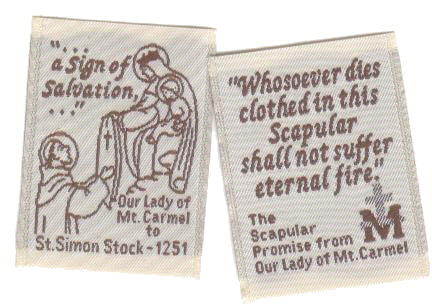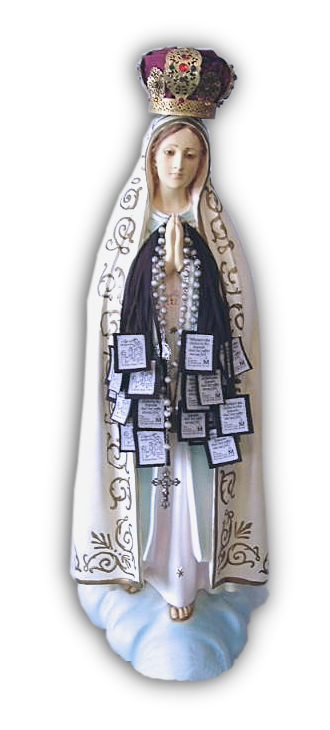|
The small scapulars consist essentially of
two quadrilateral segments of woolen cloth (about
two and three-quarter inches long by two inches
wide),
connected with each other by two strings or
bands in such a manner that, when the bands rest
on the shoulders, the front segment rests before
the breast, while the other hangs down an equal
distance at the back. The two segments of cloth
need not necessarily be equally large, various
scapulars having the segment before the breast
of the above dimensions while the segment at the
back is much smaller. The material of these
two essential parts of the scapular must be of
woven wool; the strings or bands may
be of any material, and of any one color. The
color of the segments of woolen cloth depends on
the color of the Carmelite habit, ...
The Catholic Encyclopedia
According to the Sacred Congregation of Indulgences wool is necessary and exclusively to be used in the making of scapulars. Cotton, felt, of wool woven into the fashion of lace will not suffice. A picture or decoration must never deprive the color of the Scapular of its predominance.
The Scapular Devotion -- E. P. Magennis, Order of Carmelites
Pope Saint Pius X: "... I believe in the
Scapular Vision! ... I desire most vehemently that the
cloth Scapulars be worn, as heretofore."
Benedict XV declared on July 8, 1916: "In
order that one may see that it is Our desire that
the Brown Scapular be worn, We concede to it a grace that the Scapular Medal
shall not enjoy." And the Pontiff proceeded to grant
an indulgence
of five hundred days for each time the Scapular is
kissed.
Mary in Her Scapular Promise -- John Mathias Haffert
From Mary in Her Scapular
Promise, the renowned Jesuit Moralist,
Father Vermeersch says: "I would prefer that, in order to honor the principal Scapular which is
that of Carmel, the Brown Scapular be worn in the accustomed
form and the medal only as a substitute for the other
scapulars ..."
The brown scapular must be given
separately, not with other scapulars.
Your Brown Scapular -- Most Rev. E. K. Lynch, Order of Carmelites
Code of Canon Law:
992 An indulgence is the
remission in the sight of God of the temporal
punishment due for sins, the guilt of which has
already been forgiven. A member of Christ's
faithful who is properly disposed and who
fulfils certain specific conditions, may gain an
indulgence by the help of the Church which, as
the minister of redemption, authoritatively
dispenses and applies the treasury of the merits
of Christ and the Saints.
Code of Canon Law:
1167 ß2 The rites and the
formulae approved by ecclesiastical authority
are to be accurately observed when celebrating
or administering sacramentals.
|




